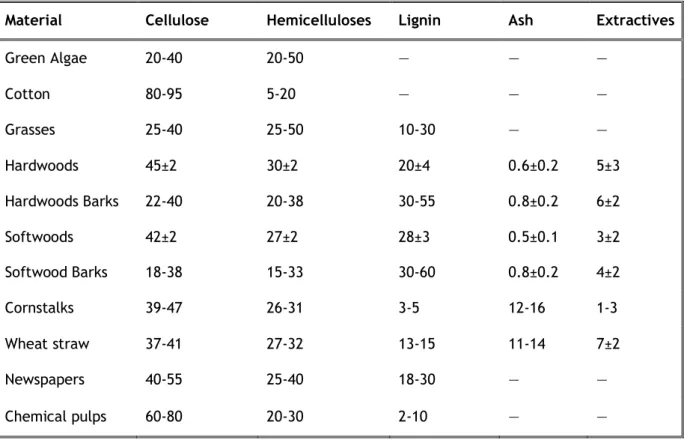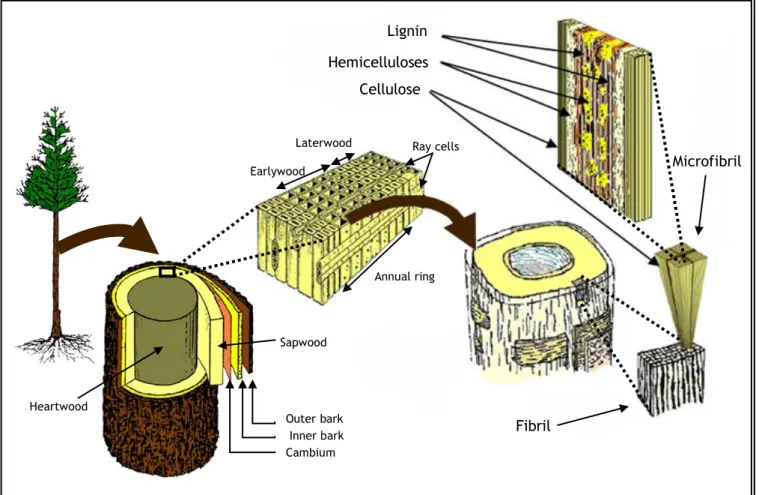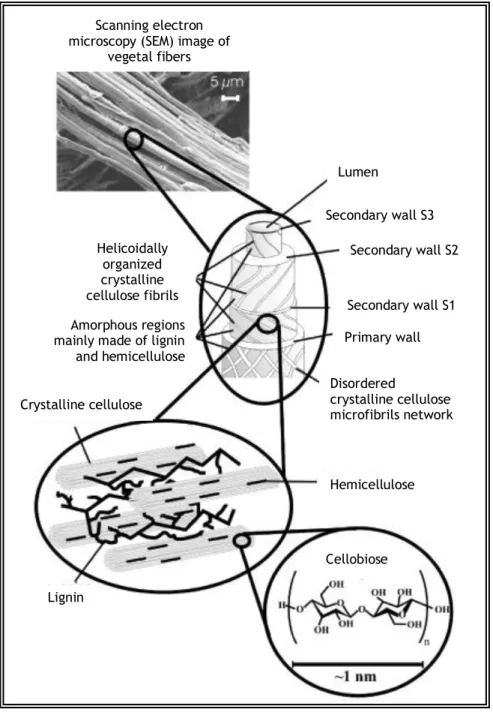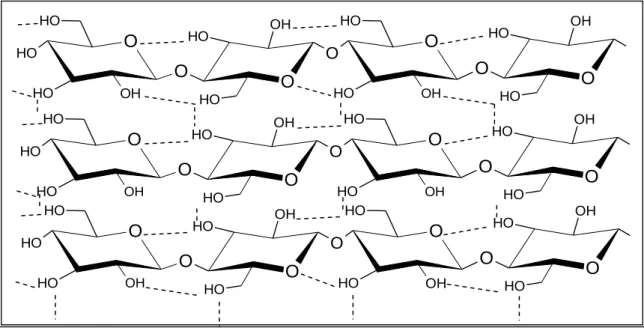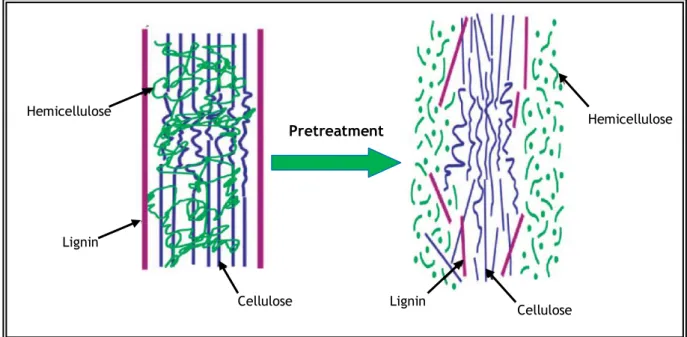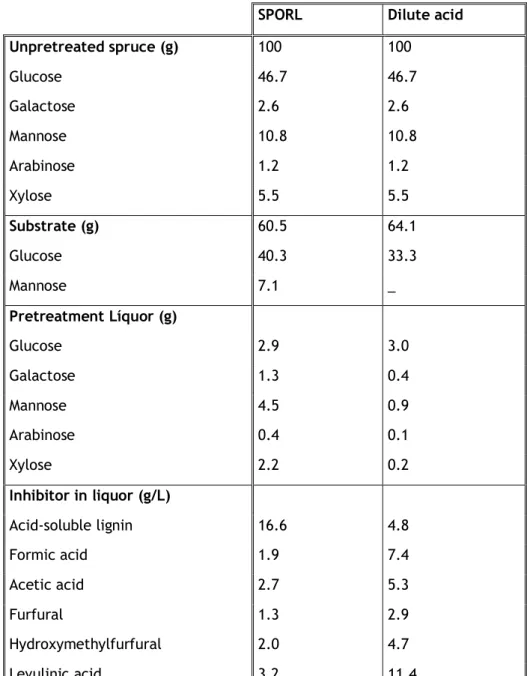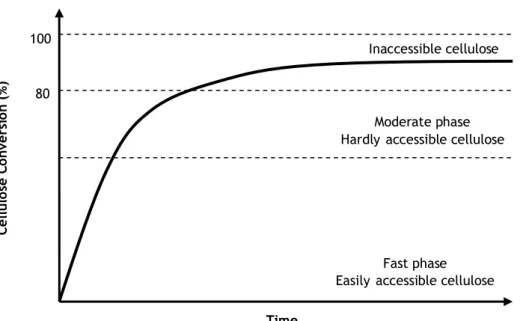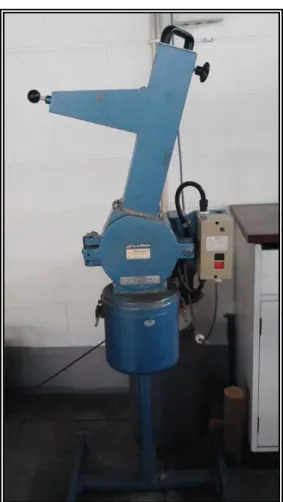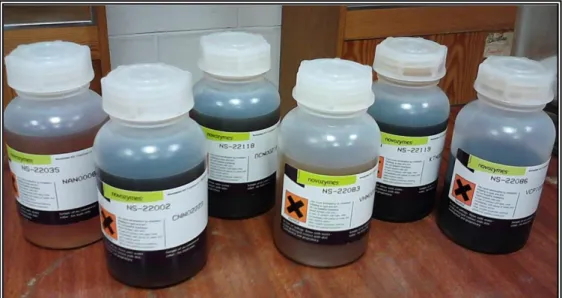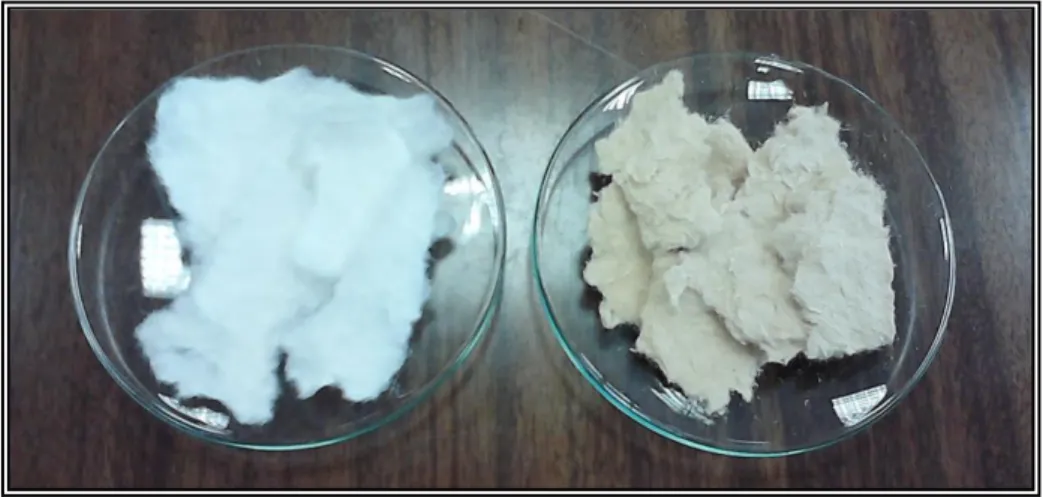UNIVERSIDADE DA BEIRA INTERIOR
Ciências
Effect of physical and physical-chemical
pretreatments on the sugar release of
lignocellulosic materials through an enzymatic
cocktail
Vera Lúcia Dias da Costa
Dissertação para obtenção do Grau de Mestre em
Química Industrial
(2º ciclo de estudos)
Dedication
Acknowledgements
Getting so close to another goal in my life, I cannot help looking back and realizing I was never alone throughout this journey: there were people without whom it would not be possible for me to carry on. For this reason, I would like to express my deep gratitude for all of you, regarding particularly the following people:
To my tutor Prof. Doutor Rogério Simões, for all the shared knowledge, patience, availability, trust and enthusiasm transmitted, even in failed attempts.
To all the teachers and lab partners who, in one way or another, contributed to the execution of the experiments and for the perseverance needed to work them out.
To my colleagues Tânia Gomes and Guilherme Neves, for all the help and support in the laboratory.
To all my friends, for the fellowship, affection, motivation, shared laughs and frustrations, and for the restorative afternoon coffees.
To God, for whispering on my ear and showing me the right path to follow, although it might not have been the easiest one.
Thanks to all of the people who, despite not being mentioned, have helped me with either a smile or a word of support.
Lastly, my deepest gratitude goes to my family and my boyfriend, who have been the ground for my feet to stand on, and the strength for me to hold on to, in every step of the way. Thank you for all the sincere love, motivation and support.
“There’s a tingling in the spine, a catch in the voice, a faint sensation as of a distant memory of falling from a great height… We know we’re approaching the grandest of mysteries.”
Abstract
This work intended to begin an investigation course which aims to deepen the mechanisms that determine the sugar release from lignocellulosic materials, using adequate enzymatic complexes. In this study, it was used an enzymatic complex, kindly provided by Novozymes, which includes a diverse set of enzymes, designed for the hydrolysis of lignocellulosic materials. Provided with this tool, the work began by evaluating the response of two model cellulosic fibrous materials: a chemical bleached pulp (with lignin-free fibers and high specific area) and a mechanical pulp (lignin-rich and also with high specific area). These choices provide high and comparable specific areas, allowing the isolation of the effect of material’s composition. While the chemical bleached pulp is mate exclusively by polysaccharides, the mechanical pulp contains all the lignin from its original wood, apart from the polysaccharides, preserving the wood’s original ultra-structure. In order to distinguish extreme cases, the pulps were also subjected to a beating process in a PFI mill, which additionally increased the material’s specific area, and were afterwards subjected to an enzymatic cocktail. The obtained results revealed completely different answers from both pulps, beaten and unbeaten. The lignin-free pulp has released practically all its carbohydrates, while the mechanical pulp released only about 20% of its potential. The pulp beating had a limited effect on the mechanical pulp and increased the sugar release rate and slightly increased its extension in the chemical bleached pulp. In conclusion, the behavior differences are not due to specific area, but to the chemical composition and/or to the differences in the ultra-structure of both fibrous materials studied. The performed studies point to a combined effect of both factors, which are difficult to isolate due to the fact that the lignin extraction process also induces modifications on the organizational structure of the polymers. The second stage of this work involved non-previously processed prime-matters, namely, pine and eucalyptus wood chips and also broom wood. In these cases, it is essential to submit the material to a pretreatment prior to subject it to enzymatic hydrolysis, aiming its sugars release. In this study, we chose to explore the sodium bisulfite potential, at different pH levels, taking into account the few published studies with this treatment, and the team’s experience on wood coking processes. Based on the literature, the operating conditions of the sulfite stage were chosen, maintaining the enzymatic hydrolysis conditions. After the pretreatment, the material was subjected to a controlled disintegration treatment. The sugars and their byproducts from the pretreatment hydrolysate were analyzed by HPLC and the solid residue was afterwards subjected to enzymatic hydrolysis. The increase on acid charge (H2SO4), for a fixed sulfite level, translated in the increase of sugar release,
higher tendency to fragment in the disintegration step. An attempt of global mass balance was undertaken with consistent results, although they might require adjustments from further investigations. Generally, all the solid residues exhibited a very positive answer on the enzymatic hydrolysis, achieving polysaccharide conversions in the range of 65 to 98%. The sugar release rate proved to be fast in the beginning, gradually decreasing with contact time, until it is annulled. In some cases, a decrease in sugar concentration in the reaction medium takes place, in around 72 hours of enzymatic hydrolysis. Since this decrease is not expectable, it can be related with the existence of microorganisms detected when hydrolyzed samples were observed in an optic microscope. The microscopic observation of samples subjected to different times of enzymatic hydrolysis revealed the enzymes’ ability of fragmenting the fibers; at the end of two days, the fibers were mostly converted to fine elements.
Key-words
Bioethanol; enzymatic hydrolysis; lignocellulosic materials; sulfite pretreatment; ultra-strucutre
Resumo
Com o presente trabalho pretendeu-se iniciar uma linha de investigação que visa aprofundar os mecanismos determinantes da libertação de açúcares de materiais lenhocelulósicos utilizando complexos enzimáticos adequados. No presente estudo utilizou-se um complexo enzimático amavelmente cedido pela Novozymes, que inclui um conjunto diverso de enzimas desenhadas para a hidrólise de materiais lenhocelulósicos. Munidos desta ferramenta, começou por avaliar-se a resposta de dois materiais fibrosos celulósicos modelo: uma pasta química branqueada (fibras livres de lenhina e com elevada área específica) e uma pasta mecânica (rica em lenhina e também com elevada área específica). Estas escolhas proporcionam áreas específicas elevadas e comparáveis, permitindo isolar o efeito da composição do material. Enquanto que a pasta química branqueada é constituída exclusivamente por polissacarídeos, a pasta mecânica contém toda a lenhina da madeira que lhe deu origem, para além dos polissacarídeos, preservando a ultra-estrutura original da madeira. Para extremar condições, as pastas foram ainda submetidas ao processo de refinação em moinho PFI, que aumentou ainda mais a área específica do material posteriormente submetido à acção do cocktail enzimático. Os resultados obtidos revelaram respostas completamente diferentes das duas pastas, refinadas ou não, com a pasta isenta de lenhina a libertar praticamente todos os seus hidratos de carbono, enquanto que a pasta mecânica libertou apenas cerca de 20% do seu potencial. A refinação teve um efeito limitado na pasta mecânica, e aumentou a velocidade de libertação dos açúcares e, marginalmente, a sua extensão na pasta química branqueada. Em conclusão, as diferenças de comportamento não se ficam a dever à área específica, mas sim à composição química e/ou às diferenças na ultra-estrutura dos dois materiais fibrosos objecto de estudo. Os estudos realizados apontam para um efeito conjunto dos dois factores, difíceis de separar em virtude de o processo de extracção da lenhina também induzir modificações ao nível da estrutura organizacional dos polímeros.
Numa segunda fase do trabalho passou a trabalhar-se com matérias-primas não previamente processadas, isto é, partiu-se de aparas de madeira de pinho e eucalipto e ainda de giesta. Nestes caso, é essencial submeter o material a um pré-tratamento antes de o submeter à hidrólise enzimática com vista à libertação dos açúcares. No presente estudo, optou-se por explorar o potencial do sulfito de sódio, a diferentes níveis de pH, tendo em conta os poucos trabalhos publicados com este tratamento e a experiência da equipa nos processos de cozimento de madeira. Com base na literatura, escolheram-se as condições de operação no estágio do sulfito, tendo-se mantido constantes as condições da hidrólise enzimática. Após o pré-tratamento, o material foi sujeito a um tratamento de desintegração controlado. No hidrolisado determinaram-se, por HPLC, os açúcares e os seus produtos de degradação, e
O aumento da carga de ácido (H2SO4), para um dado nível de sulfito, traduz-se no aumento da
libertação de açúcares, particularmente xilose, e num acréscimo dos produtos de degradação inibidores de algumas etapas seguintes no processo de produção de etanol, bem como na produção de um resíduo sólido com lenhina mais condensada (mais escuro), e uma maior tendência para a fragmentação na etapa de desintegração. Levou-se a cabo uma tentativa de balanço global de massa, tendo-se obtido resultados consistentes, mas que requerem afinação em trabalhos futuros. De uma maneira geral, todos os resíduos sólidos exibiram uma resposta muito positiva na hidrólise enzimática, tendo-se atingido conversões dos polissacarídeos na gama de 65 a 98%. A velocidade de libertação dos açúcares é rápida no início, decrescendo gradualmente com a passagem do tempo de contacto, até se anular. Em alguns casos assiste-se a uma diminuição da concentração de açúcares no meio reaccional para tempos de hidrólise da ordem das 72 horas. Esta diminuição não expectável pode estar relacionada com a existência de microrganismos detectados na observação microscópica das amostras hidrolisadas. A observação microscópica das amostras sujeitas a diferentes tempos de hidrólise enzimática revelou ainda a capacidade das enzimas para fragmentar as fibras; ao cabo de 2 dias as fibras estão maioritariamente convertidas em elementos finos.
Palavras-chave
Bioetanol; hidrólise enzimátic;, materiais lenhocellulósicos; pretratamento ao sulfito; ultra-estrutura.
Index
Chapter I - Introduction 1
Chapter II – Literature Review 3
II - 1 Vegetable Biomass 3
II - 1.1 Biomass as a source of energy 4
II - 1.2 Importance of renewable energy sources 5
II - 1.3 Bioethanol as an alternative fuel 5
II – 1.4 Production of bioethanol from lignocellulosic materials 6 II – 2 Basic components of lignocellulosic materials 7
II – 2.1 Hardwoods and softwoods 7
II – 2.2 Anatomical and morphological characterization of vegetable biomass 7
II – 2.3 Chemical structure 11
II – 2.3.1 Cellulose 11
II – 2.3.2 Hemicelluloses 12
II – 2.3.3 Lignin 13
II – 2.3.4 Extractives 14
II – 3 Lignocellulosic materials pretreatments 15
II – 3.1 Key factors for an effective pretreatment of lignocellulosic materials 17
II – 3.2 Inhibition issues 18 II – 3.3 Physical pretreatments 19 II – 3.3.1 Mechanical fragmentation 19 II – 3.3.2 Pyrolysis 20 II – 3.4 Physical-chemical pretreatments 20 II – 3.4.1 Steam explosion 20
II – 3.4.2 Ammonia fiber explosion 22
II – 3.4.3 Liquid hot-water 22 II – 3.5 Chemical pretreatments 23 II – 3.5.1 Ozonolysis 24 II – 3.5.2 Alkaline pretreatment 24 II – 3.5.3 Acid pretreatment 25 II – 3.5.4 Sulfite pretreatment 26 II – 3.5.5 Organosolv 30 II – 3.6 Biological pretreatments 31
II – 4 Hydrolysis of lignocellulosic materials 31
II – 4.1 Chemical hydrolysis 32
II – 4.2.2 Enzymatic hydrolysis of cellulose 33
II – 4.2.3 Enzymatic cocktail 34
II – 4.2.4 Limiting factors of enzymatic hydrolysis 35
II – 4.2.4.1 Structural limitations 35
II – 4.2.4.2 Enzyme-related and substrate-related limitations 36
II – 5 Fermentation 39
II –5.1 Hydrolysis and fermentation strategies 39
II –5.1.1 Separate enzymatic hydrolysis and fermentation 40 II –5.1.2 Simultaneous saccharification and fermentation 40 II –5.1.3 Simultaneous saccharification and cofermentation 41
Chapter III – Experimental part 43
III – 1 Materials and Reagents 43
III - 1.1 Biomass 43
III - 1.2 Labware 44
III - 1.3 Reagents 44
III - 1.4 Enzymatic cocktail 45
III - 1.4.1 Enzymatic cocktail preparation 46
III – 2 Analytical methods 46
III – 2.1 Dry matter content determination 46
III – 2.2 Kappa Number determination 46
III - 2.3 Water retention value determination 47
III - 2.4 Limiting viscosity number determination 48
III - 2.5 HPLC 48
III - 2.5.1 Determination of sugar content by HPLC 49
III - 2.6 Morphological analysis 50
III - 2.6.1 Fine elements quantification 50
III - 2.6.2 Optic microscopy 51
III – 3 Experimental procedures 51
III – 3.1 Measurement of cellulases activity 51
III – 3.2 Effect of pulp beating on the sugar release in the enzymatic
hydrolysis 52
III – 3.2.1 Pulp beating 52
III – 3.2.2 Enzymatic hydrolysis 53
III – 3.3 Effect of sulfite pretreatment and bleaching on the sugar release in
the enzymatic hydrolysis 54
III - 3.3.1 Biomass preparation 54
III - 3.3.2 Sulfite pretreatment 54
III – 3.3.3 Bleaching 56
III – 3.3.4 Enzymatic hydrolysis 56
III – 5 Effect of sulfite pretreatment on different woody species 57
Chapter IV – Results and discussion 61
IV – 1 Measurements of cellulases activity 61
IV – 2 Effect of pulp beating on the sugar release in the enzymatic hydrolysis 62
IV - 2.1 Enzymatic hydrolysis 62
IV - 2.2 WRV determination 65
IV – 3 Effect of sulfite pretreatment and bleaching on the sugar release in the
enzymatic hydrolysis 65
IV – 3.1 Chemical pretreatments 65
IV – 3.2 Enzymatic hydrolysis 66
IV – 3.3 Viscosity determination 68
IV – 4 Influence of pulp drying on the sugar release in the enzymatic hydrolysis 69 IV – 5 Effect of sulfite pretreatment on different woody species 70
IV – 5.1 Pretreatment analysis 70
IV – 5.2 Enzymatic hydrolysis of the sulfite pretreated material 76 IV – 5.3 Effect of enzymatic hydrolysis on fiber morphology 78
Chapter V – Conclusion and final considerations 83
Bibliographic references 85
Consulted standards and laboratory analytical procedures 92
Annexes 93
Annex A 93
Figure list
Figure 1 – Representation of the carbon cycle.
Figure 2 – Illustration of wood/plants, cell and cell wall components. Figure 3 – Representation of vegetable fibers structure.
Figure 4 – Illustration of cellulose structure.
Figure 5 – β–(1-4)-D-xylopyranosyl units from a xylan hemicellulose polymer. Figure 6 – Illustration of lignin precursors; typical structure of a softwood lignin.
Figure 7 – Scanning Electron Microscopy comparing pretreated and not pretreated corn stover subjected to enzymatic hydrolysis.
Figure 8 – Representation of the role of the pretreatment on the conversion of lignocellulosic materials to fuel.
Figure 9 – Typical time course of the enzymatic hydrolysis of cellulose.
Figure 10 – Representation of the main structural limitations of enzymatic hydrolysis of lignocellulosic materials.
Figure 11 – Chips of Eucalyptus globulus (a), Pinus pinaster (b) and branches of Cytisus striatus before (c) and after bark removal and milling (d).
Figure 12 – Grinding mill.
Figure 13 – Novozymes’ cellulosic ethanol enzyme kit. Figure 14 – Schematic representation of the HPLC apparatus.
Figure 15 – HPLC calibration curves obtained for glucose, xylose, cellobiose and acetic acid. Figure 16 – Techpap MorFi LB-01 fiber analyzer.
Figure 17 – Pinus pinaster kraft pulp and PGWP. Figure 18 – PFI mill.
Figure 19 – Thermostated water bath with continuous agitation. Figure 20 – Forced circulation digester.
Figure 21 – Laboratory strainer.
Figure 22 – Thermostated PEG bath (a) and stainless steel reactors (b). Figure 23 – Variation of glucose yield with cellulase concentration.
Figure 24 – Concentration profiles of cellobiose, glucose and xylose achieved in the enzymatic hydrolysis of unbeated PGWP and bleached kraft pulp.
Figure 25 – Concentration profiles of cellobiose, glucose and xylose achieved in the enzymatic hydrolysis of PGWP and bleached kraft pulp beaten at 3000 revolutions and a beating intensity of 1.5 N/m.
Figure 26 – Concentration profiles of cellobiose, glucose and xylose achieved in the enzymatic hydrolysis of PGWP and bleached kraft pulp beaten at 6000 revolutions and a beating intensity of 1.5 N/m.
Figure 27 – Overall carbohydrate yield for the different beating extents of PGWP and bleached kraft pulp.
Figure 28 – Evolution of the biomass appearance: (a) sulfite pretreated wood; (b) sulfite pretreated unbleached pulp; (d) bleached pulp after bleaching stage D2.
Figure 29 – Concentration profiles of cellobiose, glucose and xylose achieved in the enzymatic hydrolysis of the sulfite bleached pulp (a), unbleached pulp (b) and grinded uncooked material (c).
Figure 30 – Total carbohydrates yield of sulfite pretreated pulps (B = bleached pulp; UB = unbleached pulp; GUM = grinded uncooked material; OGUM = over grinded uncooked material).
Figure 31 – Comparison between the total carbohydrate yields of never-dried and dried bleached and unbleached pulps, throughout the enzymatic hydrolysis (B = bleached pulp; UB = unbleached pulp; UM = uncooked material; GUM = grinded uncooked material).
Figure 32 – Sulfite pretreated pine. The pretreatment liquors compositions (w/w) were, from left to right, 15% bisulfite and 0% H2SO4; 15% bisulfite and 2% H2SO4; 15% bisulfite and 5% H2SO4.
Figure 33 – Sulfite pretreated eucalyptus. The pretreatment liquors compositions (w/w) were, from left to right, 9% bisulfite and 0% H2SO4; 5% bisulfite and 0% H2SO4.
Figure 34 – Variations of the amounts of sugars and byproducts found in the hydrolysates with the acid charge of the pretreatment liquors.
Figure 35 – Variations of the amounts of glucose and xylose (a), furfural and HMF (b) found in the hydrolysates, with the acid charge of the pretreatment liquors.
Figure 36 – Total carbohydrate yield throughout enzymatic hydrolysis of pretreated eucalyptus wood.
Figure 37 – Total carbohydrate yield throughout enzymatic hydrolysis of pretreated pine wood. Figure 38 – Samples of sulfite pretreated eucalyptus during enzymatic hydrolysis, observed with
an optic microscope at 160×.
Figure 39 – Samples of sulfite pretreated broom during enzymatic hydrolysis, observed with an optic microscope at 160×.
Figure 40 – Samples of sulfite pretreated pine during enzymatic hydrolysis, observed with an optic microscope at 160×.
Figure B1 – Variation of glucose yield with cellulase concentration for the determination of cellulases activity.
Table list
Table 1 – Composition in percentage of dry weight of various types of cellulosic biomass materials.
Table 2 – Mass balance of SPORL and Dilute Acid pretreated Spruce. Table 3 – Enzyme classification, and recommended usage conditions. Table 4 – Operating conditions of the sulphite pulp bleaching.
Table 5 – Pretreatment liquor composition and operating conditions of the sulfite pretreatments. Table 6 – WRV obtained for the bleached kraft pulp and PGWP, subjected to different beating
extents.
Table 7 – Table 7 - Final pH of the hydrolysates, K-No and solid residue of the resultant solids for the different biomasses sulfite pretreatments.
Table 8 – Mass balance of the sulfite pretreatment for eucalyptus, broom and pine.
Table 9 – Fine element quantification of sulfite pretreated biomasses throughout the enzymatic hydrolysis.
Acronyms list
AFEX Ammonia fiber explosion AGU Amyloglucosidase Unit CBU Cellobiose unit CED Cupriethylenediamine DNS 3,5-Dinitrosalicylic acid DP Degree of polymerization ECF Elemental chlorine free EGU Endo-Glucanase Unit
EU European Union
FBG Fungal Beta-Glucanase Unit FGU PolyGalacturonase Unit FPU Filter paper unit FXU-S Fungal Xylanase Unit
HPLC High performance liquid chromatography ICE Internal combustion engines
IR Infrared
IUPAC International Union of Pure and Applied Chemistry
K-No Kappa number
LAP Laboratory analytical procedure NREL National renewable energy laboratory PEG Polyethylene glycol
PGWP Pressurized ground wood pulp
RI Refraction index
SEM Scanning electron microscopy
SHF Separate enzymatic hydrolysis and fermentation SSF Simultaneous saccharification and fermentation
TS Total solids
UV Ultraviolet
Chapter I - Introduction
In the last few years, the increasing and continuous consumption of energy due to the world population growth and the rising number of industrialized countries, as well as the growing carbon dioxide emission issues and the aspiration of low fossil fuels dependence, have brought into focus the need to develop sustainable green technologies for many of our most basic manufacturing and energy needs (Sun e Cheng, 2002; Jørgensen et al., 2007; Rass-Hansen et al., 2007; Pu et al., 2008; Alvira et al., 2010).
Biomass is the only renewable source of energy that can provide short-term alternative fuels, such as bioethanol or biodiesel, for the transportation sector (Rass-Hansen et al., 2007; Alvira et al., 2010). Many countries, namely Brazil and USA, frequently use ethanol as a gasoline addictive and have invested significant resources on the utilization of ethanol/gasoline blends as fuel for internal combustion engines (Rass-Hansen et al., 2007). Adding ethanol to the gasoline increases the octane number and reduces the carbon dioxide emissions (Hamelinck et al., 2005).
Bioethanol can be produced from different types of feedstock: crops of starchy vegetables such as maize grains (1st generation bioethanol), and lignocellulosic materials such as wood,
agriculture residues and waste paper, for instance (2nd generation bioethanol) (Sivakumar et
al., 2010; Balat, 2011). Although most of the global bioethanol supply comes from starchy materials, lignocellulosic materials are the most abundant feedstock for bioethanol production (Sivakumar et al., 2010).
Lignocellulosic materials are fundamentally made out of carbohydrates polymers (cellulose and hemicelluloses), lignin and a smaller amount of other compounds, such as extractives and organic acids. Cellulose and hemicelluloses, which constitute about two thirds of the dry weight, are hydrolysable polysaccharides that generate sugars which, in turn, can be fermented into ethanol. Since lignin cannot be used for ethanol production, it can be harnessed for heat production by combustion, among other uses (Hamelinck et al., 2005). In order to take advantage of lignocellulosic residues as a source of renewable energy, it is important to convert them in the largest possible amount of fermentable sugars, which means that both the glucose obtained from the cellulose and hemicellulose fraction must be taken into account, contributing to the economic viability of the process (Cara et al., 2008).
Obtaining ethanol from lignocellulosic materials takes essentially four steps: pretreatment, which breaks the lignin matrix in order to improve the fibers accessibility; hydrolysis, where the substrates are converted into sugars; fermentation, which transforms the sugars in
ethanol; and the distillation, where the previously produced ethanol is purified according to fuel specifications (Balat et al., 2008; Margeot et al., 2009; Mészáros et al., 2009).
The experiments undertaken and described in this dissertation aimed to study the effect of some physical and physical-chemical pretreatments. Two approaches were followed:
(1) Using two model lignocellulosic materials (a lignin-free bleached pulp and a lignin-rich mechanical pulp), the effect of some physical pretreatments were studied, namely beating and drying;
(2) Wood chips of three different woody species (Eucalyptus globulus, Pinus pinaster and Cytisus striatus) were pretreated with different sulfite charges at different pH levels and the effect on the sugar and fermentation inhibitors release in the hydrolysates were studied. In addition, the solid residue was submitted to the effect of an enzymatic cocktail from Novozymes, in order to investigate the sugar release.
This dissertation is divided in 5 chapters, being this introduction the first of them. Chapter II consists of a literature review about the production of bioethanol from lignocellulosic materials, their main pretreatments, types of hydrolysis and fermentation of released sugars. Chapter III describes the reagents, materials and analytical methods used in the experiments, as well as the experimental procedures undertaken. Chapter IV shows the main results obtained and discusses their meaning and significance. Chapter V resumes the main conclusions and final considerations.
Chapter II – Literature Review
II - 1 Vegetable Biomass
Vegetable biomass is created in a process called photosynthesis, where the reactions between the water, sunlight and the atmospheric CO2 originate the carbon hydrates, which are the
main foundations of all vegetable materials. In this process, solar energy is stored in the chemical bonds of the structural components of biomass as chemical energy. Thus, if the biomass is efficiently processed, extracting the stored energy, the carbon is oxidised, producing CO2 and water. The whole process is a closed cycle, as represented in the figure 1,
once the CO2 liberated is availed to produce new biomass: hence the energy obtained from
these materials is designated renewable. While the ordinary vegetable biomass can be used as a renewable source of energy, fossilized biomass, like coal or petroleum, takes millions of years until it can be used as fuel. This is the reason why fossil fuels are considered nonrenewable sources of energy. Because burning these fuels exhausts a nonrenewable resource and contributes for the greenhouse effect, by spending “old” biomass and liberating “new” CO2, this process is not a cycle (McKendry, 2002).
Harvested areas replanted
Growing trees absorb carbon rapidly Wood waste is turned into clean energy Carbon released Organic materials decay transferring carbon underground Dead materials store
carbon temporarily underground Old decaying forests release and store carbon Resources (fossil fuels extracted)
II - 1.1 Biomass as a source of energy
Biomass is generally designated as any biological material, most often referring to plants or plant-derived matter which can be transformed into diverse and appropriate types of bioenergy. In this context, examples of biomass can be wood, sawdust, agricultural residues, vegetable coal and biogas originated in organic waste decomposition. In bioengineering, much attention has been given to the production of liquid fuels from biomass (generally designated biofuels), mainly to try to ensure the transportation sector needs. Actually, until today, there haven´t been found any alternative renewable sources of fuel, apart from the biofuels, that are economically reliable and technologically mature (Zhang e Smith, 2007).
Bioethanol can be produced from different kinds of agricultural raw materials, which can be divided in three categories: simple sugars, starch and cellulose. Cellulosic materials can be supplied from a variety of inexpensive resources (Demirbaş, 2005).
Cellulosic or lignocellulosic materials are generic terms that designate the main constituents of the majority of vegetables (Ogeda and Petri, 2010).
Although the structural and chemical composition of lignocellulosic materials varies greatly with environmental and genetic issues (Ballat, 2011), the average composition of various types of cellulosic biomass materials is given in Table 1.
Table 1 - Composition in percentage of dry weight of various types of cellulosic biomass materials (Adapted from Demirbaş, 2005).
Material Cellulose Hemicelluloses Lignin Ash Extractives
Green Algae 20-40 20-50 ― ― ― Cotton 80-95 5-20 ― ― ― Grasses 25-40 25-50 10-30 ― ― Hardwoods 45±2 30±2 20±4 0.6±0.2 5±3 Hardwoods Barks 22-40 20-38 30-55 0.8±0.2 6±2 Softwoods 42±2 27±2 28±3 0.5±0.1 3±2 Softwood Barks 18-38 15-33 30-60 0.8±0.2 4±2 Cornstalks 39-47 26-31 3-5 12-16 1-3 Wheat straw 37-41 27-32 13-15 11-14 7±2 Newspapers 40-55 25-40 18-30 ― ― Chemical pulps 60-80 20-30 2-10 ― ―
II - 1.2 Importance of renewable energy sources
Nowadays, world’s economy is highly dependent on various fossil energy sources, such as oil, coal, natural gas, among others (Sarkar et al., 2012).
The transportation sector is worldwide considered to play a large role in the consumption of these energy sources, being almost entirely dependent on petroleum-based fuels. In addition, this sector requires liquid fuels. It accounts for more than 70% of global carbon monoxide (CO) emissions and 19% of global CO2 emissions (Ogeda e Petri, 2010; Balat, 2011).
The increasing number of cars on the road, registered in the last few years, its predicted growth and consequent increase of emissions, will affect the stability of ecosystems, exhaust global oil reserves and give rise to global climate effects like the increase of greenhouse gases, which contributes to global warming (Ogeda e Petri, 2010; Balat, 2011).
In addition, because the reserves of fossil fuel are limited, annual global oil production will, inevitably, begin to decline within near future. Thus, renewable sources of energy might constitute a light at the end of the tunnel, being an alternative to petroleum-based fuels (Sarkar et al., 2012).
II - 1.3 Bioethanol as an alternative fuel
Ethanol is a colourless flammable liquid, which has a boiling point of 78.4ºC, a melting point of -114.3 ªC and a density of 0.79 g/cm3. Due to its heat potential, ethanol has been largely
used as a source of heat, light and, as referred before, a fuel in the transportation sector, most specifically in internal combustion engines (Quilhó, 2011).
Basically, any of the members of the alcohol family can be used as a fuel, being ethanol (C2H5OH), methanol (CH3OH), propanol (C3H7OH) and butanol (C4H9OH) the most suitable for
motorfuels. However, only methanol and ethanol are technically and economically appropriate to be used as fuel in internal combustion engines (ICE) (Balat, 2011; Quilhó, 2011).
Unlike gasoline, ethanol is an oxygenated fuel that contains 35% oxygen, which reduces particulate and NOx emissions from combustion. Ethanol has a higher octane number (108), larger flammability limits and both higher flame velocity and vaporization heat. These features enable a higher compression rate and a lower combustion time, resulting in a greater efficiency (Balat, 2011; Quilhó, 2011).
Bioethanol has been applied directly as a gasoline improver (most commonly blended in concentrations of 10% bioethanol and 90% gasoline, known as E10) or substituent and in bioethanol-diesel blends with the particular purpose to reduce the emissions of exhaust gases (Balat, 2011).
Bioethanol can be used as a 5% blend with petrol under the European Union (EU) quality standard EN 228. This blend requires no engine modification and is covered by vehicle warranties. With engine modification, bioethanol can be used at higher levels, for example, E85 (Balat, 2011).
II - 1.4 Production of bioethanol from lignocellulosic materials
While renewable energy sources such as, for instance, the sun, the wind, the water and geothermal heat can substitute the petroleum-based fuels in energy industry, in a near future, fuel production and chemical industry may depend on biomass as an energy supply (Sarkar et al., 2012).
Regarding bioethanol, there are, nowadays, two classifications of this fuel, depending on the feedstock from which it’s produced: 1st generation bioethanol, essentially produced from
crops of starchy feedstock such as maize grains and sugarcane, and 2nd generation bioethanol,
produced from lignocellulosic based biomass, which includes agriculture and wood residues, as well as waste paper. An important part of the world’s supply of bioethanol nowadays is constituted by 1st generation bioethanol. However, lignocellulosic biomass has some
important advantages over starch crops in bioethanol production: lignocellulosic material represents a much more abundant feedstock and, unlike the crops, it does not compete for use as food. Thus, 2nd generation bioethanol is becoming widely accepted as superior to 1st
generation one (Sivakumar et al., 2010).
Bioethanol has been produced from the hydrolysation and fermentation of lignocellulosic material since the end of the 20st century, but the perspective of using bioethanol to supply
the fuel market is relatively recent (Macedo et al., 2008).
The biorefining of biomass has attracted much interest over the last few decades and, particularly in recent years, more extensive attention has been paid to the production of biofuels and biochemicals from biomass (Zhao et al., 2011).
II - 2 Basic components of lignocellulosic materials
Lignocellulosic materials are a greatly attractive feedstock in industrial terms because they can be used to produce, apart from glucose and bioethanol, a large variety of other products. For instance, when lignin is degraded, the lower molar mass fractions obtained can be used in the fabrication of polyurethane foams and phenolic resins, among others (Ogeda e Petri, 2010). The different fractions of these materials must be selectively separated according to its characteristics and requirements of the final products (Pereira Jr. et al., 2008).
Lignocellulosic materials include wood, herbaceous crops, agricultural and forestry residues, waste paper and paper products, pulp and paper mill waste, and municipal solid waste (Gong et al., 1999).
II – 2.1 Hardwoods and softwoods
Botanically speaking, softwoods are those woods that come from gymnosperms (mostly conifers), and hardwoods are woods that come from angiosperms (flowering plants). Softwoods are generally needle-leaved evergreen trees such as pine (Pinus) and spruce (Picea), whereas hardwoods are typically broadleaf, deciduous trees such as maple (Acer) and birch (Betula) (Wiedenhoeft andMiller, 2005).
Not only do softwoods and hardwoods differ in terms of the types of trees from which they are derived, but they also differ in terms of their component cells. The single most important distinction between the two general kinds of wood is that hardwoods have a characteristic type of cell called a vessel element, whereas softwoods lack these. An important cellular similarity between softwoods and hardwoods is that in both kinds of wood, most of the cells are dead at maturity even in the sapwood. The cells that are alive at maturity are known as parenchyma cells, and can be found in both softwoods and hardwoods. Additionally, despite what one might conclude based on the names, not all softwoods have soft, lightweight wood, nor do all hardwoods have hard, heavy wood (Wiedenhoeft and Miller, 2005).
II – 2.2 Anatomical and morphological characterization of vegetable
biomass
When a tree stem is cut transversely, as it is illustrated in figure 2, a portion of “heartwood” can be seen frequently as a dark-colored zone near the center of the stem. This portion is surrounded by a lightcolored peripheral zone called “sapwood” (Fujita and Harada, 2001).
Each year, tree species growing in temperate climates add one growth increment or ring to their diameter in the sapwood. For most species, this ring shows two distinct periods of growth and therefore two bands, called earlywood (springwood) and latewood (summerwood). Latewood is denser, harder, smoother, and darker than earlywood, and its cells have thicker walls and smaller cavities (Williams, 2005).
Figure 2 - Illustration of wood/plants, cell and cell wall components (Adapted from Novozymes, 2012).
The sapwood conducts water and mineral nutrients through the tissue, from the roots into the wood. In addition, the sapwood has living parenchyma tissue, which often plays some physiological role such as the storage of starch. From this point of view, the sapwood is considered an active xylem tissue (Fujita and Harada, 2001).
In contrast to sapwood, heartwood is dead xylem. Thus, heartwood does not participate in water conduction. As the tree matures, all parenchyma cells of the sapwood die, and other types of cells become occluded with pigment composed of polyphenols and flavanoids supplied mainly from the ray parenchyma (Fujita and Harada, 2001).
Fibril Microfibril Heartwood Outer bark Inner bark Cambium Sapwood Earlywood
Laterwood Ray cells
Annual ring
Lignin Hemicelluloses Cellulose
Although the conducting and physiological functions are lost in heartwood, the durability of wood against rot or insect decay is remarkably improved due to an addition of such pigments (Fujita and Harada, 2001).
The outer bark, not only provides mechanical protection to the softer inner bark, but also helps to limit evaporative water loss. Inner bark (or phloem) is the tissue through which sugars produced by photosynthesis are translocated from the leaves to the roots or growing portions of the tree. The vascular cambium is the layer between the bark and the wood that is responsible for producing both of these tissues just mentioned (Wiedenhoeft and Miller, 2005).
Digging deep into the woody biomass, the cell walls are made out of fibrils which themselves are built of microfibrils (figure 2). At a fundamental level, microfibrils are chains of cellulose covered by hemicelluloses, which, in their turn, are enclosed by lignin(Ogeda e Petri, 2010). The most common organization of the vegetable fiber components is represented in the figure 3. Each fiber is made out of complex layers: a thin primary wall surrounds the secondary wall which is, in its turn, divided in three layers (S1, S2, S3), where the intermediate layer, S2, determines the mechanical properties of the fiber. This layer consists in a series of microfibrils made of long chains of helicoidally organized cellulose disposed along the fiber. Each microfibril is, on average, 10 to 30 nm long and is built by 30 to 100 chains of cellulose packed together (Silva et al., 2009).
Figure 3 - Representation of vegetable fibers structure. The SEM image refers to eucalyptus fibers (Adapted from Silva et al., 2009).
The proportion of the wood constituents varies between species, age as well as growing stage, and also between hardwoods and softwoods. Softwoods, like the pine, for instance, have a more significant percentage of lignin than that of the hardwoods. On the other hand, hardwoods, as the eucalyptus tree, present a higher content in cellulose and hemicellulose than softwoods (Pereira Jr. et al., 2008; Sivakumar et al., 2010).
Scanning electron microscopy (SEM) image of
vegetal fibers Lumen Helicoidally organized crystalline cellulose fibrils Secondary wall S2 Primary wall Secondary wall S3 Secondary wall S1 Disordered crystalline cellulose microfibrils network Hemicellulose Cellobiose Lignin Crystalline cellulose Amorphous regions mainly made of lignin and hemicellulose
II – 2.3 Chemical structure
Woody biomass is mainly composed of structural substances (cellulose, hemicellulose and lignin), but other polymeric constituents present in lesser and often varying quantities are pectin, starch and proteins. In addition to these macromolecular components, various nonstructural and mostly low-molecular-mass compounds (extractives, acids, salts and minerals) also are present in small quantities. The relative mass proportions of structural carbohydrates and lignin can vary widely, depending on the morphological region and age of the wood (Chen, 2011).
II - 2.3.1 Cellulose
Cellulose is located mostly on the secondary cell wall. It is an organic polymer with a high degree of polymerization (1000 to 15000 sugar units), built with D-glucose monomers connected through β-1,4-glycosdic bonds (Pereira Jr. et al., 2008). The cellulosic chains are linked parallelly to one another by hydrogen bonds, as shown in figure 4. Although the strength of these bonds is relatively weak, their great number and their organization throughout the glucose chain is responsible for the resilience of the cellulose (Jørgensen et al., 2007; Ogeda e Petri, 2010; Quilhó, 2011).
Figure 4 - Illustration of cellulose structure. The dashed lines represent the inter- and intra-chain hydrogen bonding pattern (Adapted from Festucci-Busell et al., 2007).
O
O
OHO
O H O H O H O H OH O O HO
OH O H O HO
O
O H OH OH O HO
O
OHO
O H O H O H O H OH O O HO
OH O H O HO
O
O H OH OH O HO
O
OHO
O H O H O H O H OH O O HO
OH O H O HO
O
O H OH OH O HCellulose is insoluble in a large amount of solvents. The more crystalline is its structure, the less accessible it is to acid and enzymatic hydrolysis, where the polysaccharide is broken down to free sugar molecules by the addition of water (Quilhó, 2011; Batat, 2011).
The crystalline nature of cellulose in wood has been demonstrated by studies with X-ray diffractometry and polarization microscopy. This crystalline nature was also confirmed by the electron diffraction patterns of the secondary walls of wood cells in selected areas (Fujita and Harada, 2001). Biomass can also contain a small fraction of amorphous cellulose, more susceptible of undergoing hydrolysis (Pu et al., 2008; Quilhó, 2011).
II - 2.3.2 Hemicelluloses
Hemicelluloses are ramified polymer that helps keep the cellulose microfibrils together. They are made out of pentose sugars (as xylose and arabinose), hexose sugars (like mannose, galactose and glucose) and uronic acids (glucuronic and mannuronic acids) (Quilhó, 2011; Batat, 2011). Figure 5 exemplifies the structure of a xylan hemicellulose.
Figure 5 – β–(1-4)-D-xylopyranosyl units from a xylan hemicellulose polymer (Adapted from Sigma-Aldrich, 2013).
Contrary to cellulose, hemicelluloses are relatively easy to hydrolyse, due to its amorphous nature and low degree of polymerization (60 to 300 sugar units), and is very much soluble in alkaline solutions (Sun e Cheng, 2005; Kumar et al., 2009).
Commonly, the combination of cellulose and the hemicelluloses is designated as holocellulose (Williams, 2005). O O H OH OH O O OH OH O O OH OH O O OH OH OH O H2 O CH2
II - 2.3.3 Lignin
Lignin is the non-polysaccharide fraction of the lignocellulosic materials. It is a natural aromatic macromolecule that has its origin in the polymerization of coumaric, coniferyl and sinapyl alcohols (illustrated in figure 6 (a)), organized in a complex net (Jørgensen et al., 2007; Silva, 2010). The structural building blocks of lignin are joined together by ether linkages and carbon-carbon bonds (figure 6 (b)). Functional groups, including phenolic hydroxyl, aliphatic hydroxyl, methoxyl and carbonyl, may be introduced into the lignin polymer during its synthesis. They impart some polarity to the lignin macromolecule (Jørgensen et al., 2007; Silva, 2010; Chen, 2011).
O H OH O H OH H3CO O H OH H3CO H3CO
p-Coumaric alcohol Coniferyl alcohol Sinapyl alcohol
(a)
Lignin provides toughness, impermeability and resistance against microorganism attacks. It is also the most recalcitrant constituent of vegetable cell walls. The higher its portion, the higher is the resistance of the material to hydrolysis. Consequently, lignins mechanical and chemical resilience is the main reason why it is so hard to access the cellulose and hemicelluloses (Taherzadeh e Karimi, 2007; Quilhó, 2011).
II - 2.3.4 Extractives
Generally speaking, extractives are chemicals in the wood that can be extracted using solvents, being frequently classified according to the solvent used to extract them: for instance, water-soluble, toluene-ethanol–soluble or ether-soluble extractives (Rowell et al., 2005).
Although present in small fractions, extractives comprise an extraordinarily large number of lipophilic or hydrophilic substances such as fats, fatty acids, fatty alcohols, phenols, terpenes, steroids, resin acids, rosin, waxes, and many other minor organic compounds. These chemicals exist as monomers, dimers, and polymers (Rowell et al., 2005).
Extractives not only impart color, odor and taste to wood, but they also protect woods against microbial damage or insect attacks. The amount of extractives and their composition vary with respect to the botanical families, wood species, growth regions and tissues, as well as the solvent used for the extraction. In general, softwoods have higher extractives content than hardwoods. (Rowell et al., 2005; Chen, 2011).
Extractives are formed by parenchyma cells at the heartwood-sapwood boundary and are then exuded through pits into adjacent cells. In this way it is possible for dead cells to become occluded or infiltrated with extractives despite the fact that these cells lack the ability to synthesize or accumulate these compounds on their own (Wiedenhoeft and Miller, 2005). Reactions of extractives during pretreatments are complex and are strongly dependent on pretreatment chemicals (Rowell et al., 2005).
II - 3 Lignocellulosic materials pretreatments
In plants, the cell wall usually acts like a physical protection or barrier against pathogenic microorganisms, which can segregate specific hydrolytic enzymes and promote the fibres destruction. The issues involving the enzymatic digestibility are related, at a macro scale, not only with the size of the particle of biomass, but also with the overall porosity of the cell wall. At a micro scale, these issues are directly connected with the cellulose crystallinity, its polymerization degree, with the ramifications of the hemicellulose chain and with the composition of the lignin. Thus, it is important to modify these either chemical or physical properties of the cell wall in order to magnify the biologic conversion of the cellulose into sugars, in a process known as saccharification (Balat et al., 2008; Sousa et al., 2009).
The pretreatment stage promotes disruption of the lignocellulosic matrix in order to facilitate enzyme-catalyzed hydrolysis (Chen, 2011).
Feedstock pretreatment is one of the most critical steps in biochemical conversion of lignocellulose for commercial production of biofuel and bioproducts (Wang et al., 2009). Figure 7 illustrates a comparison between a Scanning Electron Microscopy (SEM) of corn stover subjected only to enzymatic hydrolysis (a) and the same feedstock subjected to pretreatment prior to enzymatic hydrolysis (b). The results show that pretreatment changes lignocellulosic-structure susceptibility to be attacked by enzymes.
Figure 7 – Scanning Electron Microscopy comparing pretreated and not pretreated corn stover subjected to enzymatic hydrolysis: (a) A corn stover particle shows a smooth surface with a few micron-sized pores after only enzymatic hydrolysis. 11% of cellulose has been converted to glucose in 3 hours; (b) Corn stover particle with many more pores. It was pretreated in water at 190°C for 15 min and hydrolyzed by enzymes at 50°C for 3 hours, resulting in 40% cellulose conversion to glucose (Adapted from Houghton et
The main objectives of every lignocellulosic material pretreatment are, therefore, to modify or remove any structural obstruction, breaking the lignin barrier and opening the crystalline regions of the cellulose, in order to improve the fermentable sugars yield, remove acetyl group for eliminating its interference with enzyme recognition to cellulose, reducing particle size or increasing the porosity of the substrates for facilitating the penetration of hydrolysis agents (Gong et al., 1999; Balat et al., 2008; Zhao, 2010). Figure 8 represents the role of the pretreatment in the conversion of lignocellulosic materials to fuel.
Figure 8 - Representation of the role of the pretreatment in the conversion of lignocellulosic materials to fuel (Adapted from Kumar et al., 2009).
The pretreatment has to be efficient enough so that the resultant material can easily be accessed and hydrolyzed, and it cannot be so severe that it originates byproducts that can likely inhibit the microbial metabolism of the sugars into bioethanol (Kumar et al., 2009; Balat, 2011).
Although the pretreatment is necessary to enhance the obtainment of fermentable sugars from lignocellulosic material, it is considered as one of the most expensive processing steps. The major goal, concerning bioethanol production, is to develop pretreatment technologies that comprise an acceptable overall cost-benefit relation, since the efficiency of this stage will have an economical impact on every step of the lignocellulosic biomass refinery for the production of either fuels or chemical compounds (Balat et al., 2008; Kumar et al., 2009; Sousa et al., 2009). Hemicellulose Hemicellulose Lignin Lignin Cellulose Cellulose Pretreatment
Ultimately, each feedstock and pretreatment combination should be evaluated on an individual basis to determine the best process configuration to enable the industry implementation (Novozymes, 2012).
II - 3.1 Key factors for an effective pretreatment of lignocellulosic
materials
For the pretreatment to be considered effective, the following requirements must be taken into account:
High yields for multiple crops and harvesting times.
It has been shown that various pretreatments are more suitable for specific feedstocks, depending on their type (from hardwood or softwood to agriculture residues), their origin (crops, agricultural and wood residues, etc.) and harvesting time, among others (Chandra et al., 2007; Pan and Zhu, 2011).
Highly digestible pretreated biomass.
Cellulose from pretreatment should be readily digestible with yields higher than 90% in less than five or, preferably, less than three days, with an enzyme loading lower than 10 FPU/g cellulose (Yang and Wyman, 2008; Pan and Zhu, 2011).
No significant sugars degradation.
Through the pretreatment step, high yields of fermentable sugars should me achievable in the hydrolyzation stage, with no sugar loss by degradation: in other words, maximization of overall sugar recovery (Oliva et al., 2003; Yang and Wyman, 2008, Kumar et al., 2009; Pan and Zhu, 2011).
Minimum amount of toxic compounds/ fermentation inhibitors.
Harsh conditions during pretreatment can lead to partial hemicellulose degradation and also to the generation of toxic compounds resultant of the sugar decomposition, which can influence the proceeding hydrolysis and fermentation steps, mainly by inhibition. The liquid hydrolyzate from pretreatment must be fermentable following a low-cost, high yield conditioning step (Oliva et al., 2003; Pan and Zhu, 2011).
Effective biomass size reduction.
The biomass fragmentation should be carried out in low cost reactors through minimizing their volume, employing appropriate materials of construction for highly corrosive chemical environments, and keeping operating pressures reasonable (Yang and Wyman, 2008).
Non-production of solid-waste residues.
The chemicals formed during the pretreatment step should not represent a disposal issue (Alvira et al., 2010).
Obtainment of high sugar concentration.
The sugars concentration obtained from the coupled operations of pretreatment and enzymatic hydrolysis should be above 10% in order to ensure an adequate ethanol concentration at the end of the fermentation stage and to keep recovery and other downstream cost manageable (Alvira et al., 2010).
Fermentation compatibility.
The distribution of sugar recovery between pretreatment and subsequent enzymatic hydrolysis should be compatible with the choice of an organism able to ferment pentoses in hemicellulose (Yang and Wyman, 2008).
Lignin recovery.
Lignin should be recovered with the purpose of simplifying downstream processes or for conversion into valuable coproducts (Yang and Wyman, 2008).
Minimum heat and power requirements.
Heat and power demands for pretreatment should be low and/or compatible with the thermally integrated processes (Yang and Wyman, 2008; Kumar et al., 2009; Alvira et al., 2010).
II - 3.2 Inhibition issues
Lignocellulosic hydrolysates are complex mixtures of hexose and pentose sugars together with other compounds some of which can act as fermentation inhibitors (Weber et al., 2010). Different pretreatments deliver different inhibitor profiles. Inhibitors of enzymes are not necessarily the same as for microorganisms (Novozymes, 2012).
During the pretreatment, aliphatic acids such as acetic and formic acids might originate from wood extractives, lignin degradation and sugar degradation (Chen, 2011).
Based on their origin, inhibition compounds are divided in three main groups: weak acids (formic, levulinic and acetic acids), furan derivatives (furfural and 5-hydroxy-2-methyllfurfural (HMF), from pentose and hexose sugars respectively), and phenolic compounds (lignin degradation products) (Araque et al., 2008; Novozymes, 2012). It also was indicated that the lignin-degradation products have a more inhibitory effect on the fermentation microorganisms than the sugar-derived products (Chen, 2011).
On the other hand, sugar degradation products appear to bethe strongest cellulase inhibitors, followed by lignin degradation products, whereas organic acids, salts, and oligomers are weaker enzyme inhibitors (Novozymes, 2012).
Adaptation of bacteria and yeast to the potentially toxic substances to increase their tolerance is another method to overcome inhibition without involvement of expensive and complicated procedures (Chen, 2011), but ultimately, optimization of pretreatment conditions is the best approach to minimize the formation of inhibitors that are not intrinsically present in the biomass feedstock and to provide a cost-conscious balance between substrate accessibility and inhibitor formation. (Novozymes, 2011).
II - 3.3 Physical pretreatments
According to what has been said previously, bioconversion of lignocellulosic materials to bioethanol begins with the pretreatment, which can be divided into three categories: physical, physical-chemical and chemical (Balat, 2011).
Usually, the lignocellulosic materials processing starts with physical pretreatments that involve the breakdown of the biomass feedstock into smaller particles, increasing the specific surface area and disruption of the cellulose crystallinity, so that the fibres accessibility can be improved in the subsequent stages (Chandra et al., 2007; Balat et al., 2008). However, the physical pretreatments do not result in lignin removal, which has been shown to restrict the efficiency of the succeeding processing stages (Chandra et al., 2007).
There has been recently suggested another physical pretreatment which consist in irradiating cellulose with gamma rays, cleaving the β-1,4-glycosidic bonds, thus giving a larger surface area and a lower crystallinity. Despite being applicable at a small scale, this method is far too expensive to be used in a full-scale process. Furthermore, it is also doubtful that it can be used in combination with technologies supposed to be environmentally friendly (Galbe and Zacchi, 2007).
II - 3.3.1 Mechanical fragmentation
Although the mechanical fragmentation alone is not enough to increase the sugar conversion, the lignocellulosic materials processing requires a particle maximum size reduction, so that they can be effective (Sousa et al. 2009). The size reduction of the lignocellulosic material can be achieved by a combination of chipping, grinding and milling, in order to reduce cellulose crystallinity or its polymerization degree (Kumar et al., 2009; Sousa et al. 2009; Balat, 2011).
Power requirements of mechanical fragmentation depend on the final particle size and the biomass characteristics. It increases rapidly with decreasing particle size. Besides being energy intensive, fragmentation techniques are also time-consuming and expensive (Balat, 2011). Besides, it is important to perceive that when a very small particle size is reached, a huge amount of energy has been consumed, and the method becomes economically unworkable (Sousa et al. 2009).
II - 3.3.2 Pyrolysis
Pyrolysis has been used as a pretreatment for lignocellulosic biomass, since it can be used as substrate for a fast pyrolysis for thermal conversion of cellulose and hemicelluloses into fermentable sugars with reasonable yields. When cellulosic materials are subjected to high temperatures (above 300ºC), cellulose rapidly decomposes to produce gaseous products and residual char (Sun, 2008; Balat, 2011). At lower temperatures, the decomposition is much slower, and the products formed are less volatile. The pyrolysis process is enhanced when carried out in the presence of oxygen (Kumar et al., 2009).
II – 3.4 Physical-chemical pretreatments
This category on pretreatments includes mixtures of purely physical and chemical methods, and methods in between those two (Galbe and Zacchi, 2007).
II – 3.4.1 Steam explosion
Steam pretreatment, also known as steam explosion, is one of the most widely used methods for pretreatment of lignocellulosic materials (Galbe and Zacchi, 2007; Balat, 2011).
According to this method, the raw material is treated with high-pressure saturated steam at a temperature typically between 160 and 240ºC (corresponding to a pressure between 6 and 34 bar), which is maintained for several seconds to a few minutes, after which a swift cooling and an adiabatic expansion takes place, making the materials undergo an explosive decomposition, hence the designation of the pretreatment (Emmel et al., 2003; Galbe and Zacchi, 2007; Sousa et al., 2009).
During the steam explosion pretreatment, the overall crystallinity of the cellulose is increased by the crystallization of its amorphous portions. Hemicelluloses are thought to be hydrolyzed by acetic and other acids released during the pretreatment and found in the liquid phase as oligomeric and monomeric sugars and there is evidence that steam explosion promotes delignification to a limited extent, since lignin is redistributed on the fiber surfaces occurs as a result of melting and depolymerization/repolymerization reactions.
Depending on the severity of the pretreatment, some degradation of the cellulose to glucose can take place (Galbe and Zacchi, 2007; Kumar et al., 2009; Balat, 2011).
Addition of H2SO4 or CO2, usually between 0.3 to 3% (w/w), can substantially decrease time
and temperature needed, effectively improve hydrolysis, decrease inhibitory compounds production and completely remove hemicellulose. Actually, for the pretreatment of softwoods, adding an acid as a catalyst is a prerequisite to increase the accessibility of the substrate (Kumar et al., 2009).
Since it’s difficult to find conditions that originate high yields of both hexose and pentose sugars, and at the same time also create a cellulose fraction which is easy to hydrolyze to glucose, a two-stage steam explosion pretreatment may be useful: it has been suggested that two-stage pretreatment using H2SO4 impregnation in the first stage under mild conditions, followed by SO2 impregnation in the second stage under harsher conditions, could be advantageous due to the difference in optimal pretreatment conditions between cellulose and hemicelluloses, thus obtaining high yields of both sugars and avoiding the release of fermentation inhibitors (Galbe and Zacchi, 2007; Chen, 2011). Thereby, it’s relatively easy to optimize the pretreatment conditions so that it is effective for a large variety of vegetal biomass (Emmel et al., 2003).
Although it has some attractive advantages, such as high ethanol yield, better utilization of raw materials and lower enzyme consumption, two-stage steam explosion pretreatment requires economic analysis to determine whether these advantages outweigh the extra cost involved (Chen, 2011).
The major issues that can influence this pretreatment are residence time, temperature, particle size and catalyst addiction, which can be sulfuric acid or sulfur dioxide (Sassner et al., 2008). However, experiments made without addiction of catalysts report conversions in xylose between 45 and 65% (Hamelinck et al., 2005).
Among the advantages of steam explosion pretreatment, it is important to emphasize the low energy requirement compared to mechanical fragmentation (about 70% less, to achieve the same size particle reduction) (Kumar et al., 2009).
Nevertheless, using steam explosion to pretreat woody biomass produces a substrate containing a significant amount of lignin. Alkali post-treatment has been applied to steam exploded biomass to remove residual lignin (Chen, 2011).
II – 3.4.2 Ammonia fiber explosion
Ammonia fiber explosion (AFEX) is a method which, similarly to the steam pretreatment process, operates at high pressures. The biomass is treated with liquid ammonia (up to 2 kg per kg of dry biomass) for about 10 to 60 minutes at temperatures below 100 ºC and pressure above 3MPa). The ammonia is recycled after pretreatment by reducing the pressure, as ammonia is very volatile at atmospheric pressure. During pretreatment only a small amount of the solid material is solubilized which means that almost no hemicellulose or lignin is removed. However, the materials structure is changed resulting in an increasing of the water holding capacity, decrystallization of cellulose, partial depolymerization of hemicellulose, deacetylation of acetyl groups and a higher enzymatic digestibility. Shao et al. (2010) concluded that AFEX-pretreated starchy substrates had a 1.5 to 3 times higher enzymatic hydrolysis yield compared with untreated substrates, which means that AFEX effects on lignocellulosic biomass can be an important factor that influences the yield on enzymatic hydrolysis and microbial fermentation (Chundawat et al., 2006; Galbe and Zacchi, 2007; Kumar et al., 2009; Shao et al., 2010).
Despite performing best on agricultural waste and have attractive economics compared to several leading pretreatment technologies, AFEX has not proven to be efficient on wood due to its higher lignin content. Nevertheless, this process does not produce inhibitors that may affect downstream biological processes (Chundawat et al., 2006; Galbe and Zacchi, 2007).
II – 3.4.3 Liquid hot-water
Liquid hot-water pretreatment, also designated hydrothermolysis, uses water as media to pretreat biomass under pressure, maintaining it in the liquid state at elevated temperatures (160-240 ºC). It converts approximately 40–60% of the total biomass with 4–22% of the cellulose and nearly all of the hemicellulose to originate liquid soluble oligosaccharides. Although lignin is partially depolymerized and solubilized, complete delignification is not possible using hot water alone, since water cannot solubilize a large amount of lignin fragments. Condensation and redeposition of dissolved lignin onto fiber surface can also happen during hot-water pre-treatment, especially at high temperatures. It is also likely that structural and chemical changes occur to the lignin during hot-water pretreatment as well, but this phenomenon is yet to be confirmed by more effective analytical methods (Monsier et al., 2005a; Zhao, 2012). It has been proven though, that liquid hot-water pretreatment decreases cellulose crystallinity, increases its depolymerization and hydrolyzes almost all of the hemicellulose, which contributes to enhance cellulose accessibility (Zhao, 2012).
In order to avoid the formation of inhibitors during the hot-water pretreatment, the pH should be kept between 4 and 7 because, at this pH level, hemicellulosic sugars are retained in oligomeric form and monomers formation is minimized. Therefore the formation of degradation products is also lower (Mosier et al., 2005).
It is believed that, throughout the hot-water pretreatment, cell wall disruption occurs, associated with a rupture of glycosidic bonds in hemicelluloses and amorphous regions of cellulose, essentially due to hydrolytic mechanisms. Moreover, cleavage of O-C-O bonds and methoxyl groups in lignin, and depolymerization of lignin down to relatively small subunits take place (Zhao, 2012).
Liquid hot-water has been shown to remove up to 80% of the hemicellulose and to enhance the enzymatic digestibility of pretreated material in herbaceous feedstocks, such as corn, sugarcane bagasse and wheat straw (Alvira et al., 2010).
Two-step pretreatments have been studied to optimize hemicellulosic sugars recovery and to enhance enzymatic hydrolysis yields. Yu et al. (2010) have developed a two-step liquid hot-water pretreatment with the objective of achieving complete saccharification of both hemicellulose and cellulose of Eucalyptus grandis. In the first step, the highest yield of total xylose was achieved after 20 minutes at 180ºC. The optimum conditions, with minimal sugar degradation, for the second step were at 200ºC for 20 minutes, since it was found that the conversion into sugars is more sensitive to temperature than it is to time. The total sugar recovery from E. grandis with the optimized pretreatment and 72 hours of enzymatic hydrolysis, reached 96.63%, which is superior to the recovery from a single-step pretreatment with liquid hot-water or dilute acid (Yu et al., 2010).
In general, liquid hot-water pretreatments are attractive from an economic point of view, since they require no catalyst and involve low-cost reactors, because there is a low corrosion potential. In comparison to steam explosion, lower formation of inhibitors is obtained. However, water demanding in the process and energetic requirements are higher. Furthermore, this pretreatment is not yet developed at commercial scale (Alvira et al., 2010).
II - 3.5 Chemical pretreatments
In the following section, the major chemical pretreatment technologies are presented. They diverge essentially in the kind of chemical compounds used and mechanisms responsible for the structural disruptions and chemical modifications (Sousa et al., 2009).
